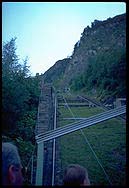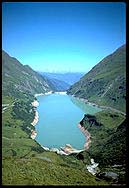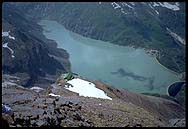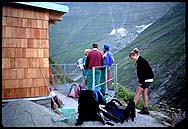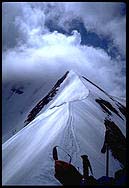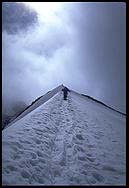Climbing the Sound of Music | Kitzsteinhorn | Sommerstein | Persailhorn | Großes Wiesbachhorn | The "Austria-Weg" | Granatspitze & Sonnblick | Hochkönig
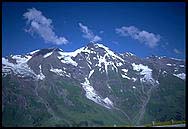
Großes Wiesbachhorn,
F+
August 12, 1997
The Nordwestgrat of Großes Wiesbachhorn (known as the "Kaindlgrat''), is among the most popular snow routes in Austria. The route was first ascended by Th. Harpprecht and A. Hetz (from the OEAV) on March 9, 1868. Today, and thanks in great part to the availability of the Heinrich-Schwaiger-Haus along the way, the Kaindlgrat is ascended by thousands of climbers every year.
In Washington, the original plan was to do the classic Heidnische Kirche - Oberwalderhütte - Heinrich-Schwaiger-Haus circuit which would have taken us on a three-day alpine tour at the heart of the Nationalpark Hohe Tauern. This tour is grandiose, allowing you to climb Klockerin (3335 m), Hinterer Bratschenkopf (3412 m), and Großes Wiesbachhorn (3570 m) along the way. However, the tour requires the ascent of the Karlingerkees glacier up to the Riffltor saddle (3116 m) and this exposes aspiring parties to one of the most crevassed glacier paths in the eastern Alps.
As a precautionary measure Monika, Eduardo, and I decided to hike the initial stretch of the route to the base of the Karlingerkees the day before the start of the big tour. Shortly after we left the main trail along the eastern shore of the Stausee Mooserboden, the going became slow due to unusually high brush along the way. Upon arriving at the base of the Karlingerkees we discovered that the glacier had not been crossed since the last snowfall weeks before. Furthermore, the hanging portion of the glacier was very unstable hurling a couple of refrigerator-size blocks of ice down its slopes in the little time that we were there. With the realization that crossing the Karlingerkees in those conditions would have been tinkering with our lives, we decided to scrap the tour in favor of a one-day ascent of Großes Wiesbachhorn.
The
first bus/lift up the Hochgebirgs-Stauseen
(also called "Mooserbodenstraße'') departs just after 7:00 and 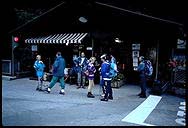 this
allowed for yet another lazy-man alpine start at 5:00 in this
the land of civilized climbing.
The drive to the lift follows the same path as if you were going to Kitzsteinhorn but
you continue the road to its end. There you encounter a free,
multi-level
parking garage that can hold in excess of 500 cars (yes... just like
those
the National Park Service provides in the US :-). The first bus is
mostly
filled with the people that work at the various jobs in the Heidnische
Kirche area. Its first stop is at the Talstation (1209 m) were a small
number of climbers hop in. From there, the trip up the
Mooserbodenstraße
takes just under 45 min. and costs ÖS175 (round trip) for OEAV
members.
this
allowed for yet another lazy-man alpine start at 5:00 in this
the land of civilized climbing.
The drive to the lift follows the same path as if you were going to Kitzsteinhorn but
you continue the road to its end. There you encounter a free,
multi-level
parking garage that can hold in excess of 500 cars (yes... just like
those
the National Park Service provides in the US :-). The first bus is
mostly
filled with the people that work at the various jobs in the Heidnische
Kirche area. Its first stop is at the Talstation (1209 m) were a small
number of climbers hop in. From there, the trip up the
Mooserbodenstraße
takes just under 45 min. and costs ÖS175 (round trip) for OEAV
members.
 The
hike up to the Heinrich-Schwaiger-Haus (2802 m) is steep but very easy.
On our way up, we were trailed by a family group from Maishofen
(Monika's hometown). The group consisted of Annie (a classmate of
Monika's
older sister), her husband Wolfgang, his father, and a climbing buddy
of
Wolfgang's father. They tried to keep up with us, but drinking the
night
before did not help their cause.
The
hike up to the Heinrich-Schwaiger-Haus (2802 m) is steep but very easy.
On our way up, we were trailed by a family group from Maishofen
(Monika's hometown). The group consisted of Annie (a classmate of
Monika's
older sister), her husband Wolfgang, his father, and a climbing buddy
of
Wolfgang's father. They tried to keep up with us, but drinking the
night
before did not help their cause.
Upon arriving at the
Heinrich-Schwaiger-Haus we
learned that our packs
were still at the bottom and that it would take a half-hour for them to
be brought up.
With little choice in the matter, I resigned myself to enjoy the
pleasures
provided by the München chapter of the DAV in their huts. 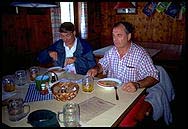 Our
companions
arrived a bit latter and proceeded to instruct us on proper
mountaineering
etiquette by eating a wholesome hut-breakfast -- Radler (1/2 beer, 1/2
Sprite) and Würstelsuppe (Frankfurter/noodle soup).
Our
companions
arrived a bit latter and proceeded to instruct us on proper
mountaineering
etiquette by eating a wholesome hut-breakfast -- Radler (1/2 beer, 1/2
Sprite) and Würstelsuppe (Frankfurter/noodle soup).
During breakfast we learned that Annie's father-in-law is a professional mountain guide and that this climb was his n-th time up Großes Wiesbachhorn. As it turns out, the sole purpose of their ascent was to introduce Annie to the family business. So while we geared-up outside the hut, Monika translated the welcome Beta.
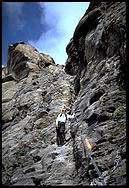 As
suggested by Annie's father-in-law, we roped-up right outside the hut
because
the
As
suggested by Annie's father-in-law, we roped-up right outside the hut
because
the 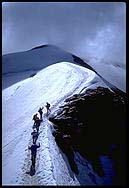 initial section of the
Nordwestgrat takes you up an awkward chimney
(grade I {i.e., 5.2}). The chimney leads to a small rock
platform just prior to the start of the Kaindlgrat (3022 m), which is
about
the size of the average bathroom. This platform tends to be very
crowded
and this makes dressing, roping-up, and cramponing there
difficult.
initial section of the
Nordwestgrat takes you up an awkward chimney
(grade I {i.e., 5.2}). The chimney leads to a small rock
platform just prior to the start of the Kaindlgrat (3022 m), which is
about
the size of the average bathroom. This platform tends to be very
crowded
and this makes dressing, roping-up, and cramponing there
difficult.
We cramponed and carefully descended the last few meters of the rock scramble to the start of the Kaindlgrat. It was late in the morning and the climbers that had slept in the Heinrich-Schwaiger-Haus, and had started the climb earlier in the morning, were struggling to pass around us while we were fidgeting with sharp objects.
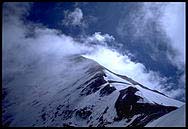 At
the end of the Kaindlgrat (3265 m) the climbing started proper. The
first
obstacle was a short 35-40° snow slope that lead to a grade I
{i.e., 5.2} rock scramble of indescribable exposure. This was
for
real; either one of us would miss a step and both would fall over 1000
m into the jaws of one of the crevasses at the base of the north-wall.
To make the scramble a bit easier, I suggested that we take our
crampons
off, which, although time consuming, put and end to the nerve wrecking
scratch of the crampons against the rock.
At
the end of the Kaindlgrat (3265 m) the climbing started proper. The
first
obstacle was a short 35-40° snow slope that lead to a grade I
{i.e., 5.2} rock scramble of indescribable exposure. This was
for
real; either one of us would miss a step and both would fall over 1000
m into the jaws of one of the crevasses at the base of the north-wall.
To make the scramble a bit easier, I suggested that we take our
crampons
off, which, although time consuming, put and end to the nerve wrecking
scratch of the crampons against the rock.
As we went up, time slowed down, and I fell into a mental state in which thoughts were very simple, but very clear. The light was very clear and I felt like I was waking towards its distance source. I treated every step as a new acquaintance. The wind increased the higher we went and we could not see anybody else in the mountain. This made the sense of isolation very real.
"I am not sure I can make it...'' Monika said. She had had just about as much as she could take, and my words of encouragement were falling on deaf ears. The blisters on her heals were murdering her even through the two layers of mole-skin she was wearing. I knew that any faith she had placed in me at the start of the day, had long worn off, so I divided my time between encouraging her to continue, and blaming myself for putting her through this ordeal. We needed to get to the top soon if we were going to finnish this mountain.
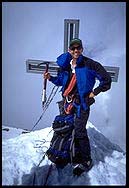 "Monika... I see the Cross just a few
meters ahead'' I
yelled into the wind. With the sight, she jumped back to life and
climbed with renewed energy. We had made it; four hours and 1530 mH
later we where standing on top of the 277th tallest mountain in Europe
(i.e., 3570 m -- not very impressive by modern alpine standards
but definitely a triumph for a week-end climber forcing his wife to be
his rope mate). Annie's party greeted us with the proverbial "Berg
Heil!'' while I tied us to the summit cross. Monika talked to her
friends in incomprehensible Pinzgau dialect and I took the camera out
to take the mandatory summit pictures. It was 13:45 and Monika wanted
to enjoy the moment at the summit; however, I wanted to go down as fast
as possible so we could make the last bus out of Heidnische Kirche. I
needed to sleep in my own bed...
"Monika... I see the Cross just a few
meters ahead'' I
yelled into the wind. With the sight, she jumped back to life and
climbed with renewed energy. We had made it; four hours and 1530 mH
later we where standing on top of the 277th tallest mountain in Europe
(i.e., 3570 m -- not very impressive by modern alpine standards
but definitely a triumph for a week-end climber forcing his wife to be
his rope mate). Annie's party greeted us with the proverbial "Berg
Heil!'' while I tied us to the summit cross. Monika talked to her
friends in incomprehensible Pinzgau dialect and I took the camera out
to take the mandatory summit pictures. It was 13:45 and Monika wanted
to enjoy the moment at the summit; however, I wanted to go down as fast
as possible so we could make the last bus out of Heidnische Kirche. I
needed to sleep in my own bed...
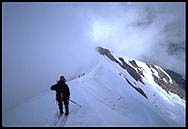 We
ran down the mountain. The snow was too soft to glissade but we took
our
crampons off in the rock sections to speed up things. The views coming
down were more impressive than going up, or at least my mind could
enjoy
them more in my exodus rush. Monika threatened with throwing the camera
down the north-face if I continued to stop to take "silly'' pictures.
People were still going up as we approached the end of the Kaindlgrat.
The last party was not even wearing crampons - one of the craziest
things
I saw during this vacation. We climbed the last steps into the small
rock
platform and then striped.
We
ran down the mountain. The snow was too soft to glissade but we took
our
crampons off in the rock sections to speed up things. The views coming
down were more impressive than going up, or at least my mind could
enjoy
them more in my exodus rush. Monika threatened with throwing the camera
down the north-face if I continued to stop to take "silly'' pictures.
People were still going up as we approached the end of the Kaindlgrat.
The last party was not even wearing crampons - one of the craziest
things
I saw during this vacation. We climbed the last steps into the small
rock
platform and then striped.
Annie's group continued their way down the rock scramble roped, but we had figured that there was no need for the rope on our way down. We got to the Heinrich-Schwaiger-Haus at 15:30. I tried to buy the mandatory hut-pin but the attendant assistant didn't know where they were stacked. We drank a glass of syrup-water and off we went, this time with the packs on our backs.
Blisters finally caught up with me on the way down. The boots of the Gods my ass... If I had had another pair of shoes in the pack I would have hurled them down the abyss. Now it was Monika who encouraged me to not slow down. We needed to be at Heidnische Kirche by 16:30 or else we would spend a pretty cold bivouac in the Moosersperre.
16:20 and we still
had to cross the damn
walls. I kept
on thinking how futile the running down had been given that we could
have
spend the night at Heinrich-Schwaiger-Haus. "No way that bus is
leaving
without me...'' I though. So I placed my blisters out of my mind and
started
running over the concrete wall towards the Heidnische Kirche. Once over
the Moosersperre we saw the bus on its way up and I was able to
relax.
The day had been a
long one. We were tired, but I
couldn't recall a
moment in which I had felt so content before. As the attendant of the
Lärchwand
Schrägaufzug saluted me with the proverbial "Berg Heil!,'' I
smiled
and dreamed of the Wiener Schnitzel waiting for me at Mama's Haus.
|
|
|
|
 Pedro
I. Espina,©
1997
Pedro
I. Espina,©
1997